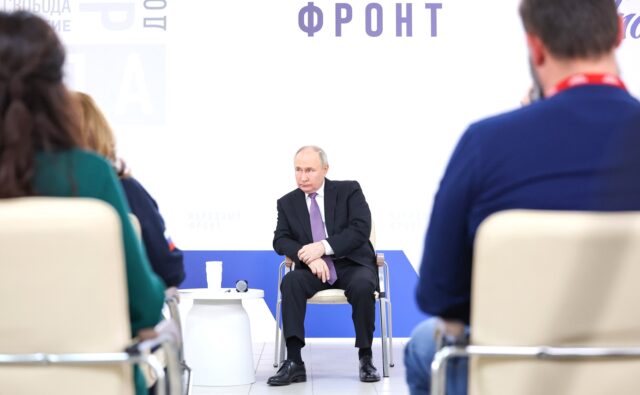
Putin’s ‘Active Measures’ and Hidden Discussion Between the Kremlin and Military
Publication: Eurasia Daily Monitor Volume: 21 Issue: 21
By:

Executive Summary:
- Discrepancies between Russian President Vladimir Putin’s claims and reality regarding the size and productivity of the Russian military-industrial complex are becoming more apparent as the war in Ukraine continues.
- Official analysis contradicts public statements on the size and success of the Russian military-industrial complex from Putin and other officials, highlighting Russia’s backlog in development and arms manufacturing.
- Doubts expressed by influential figures in the Kremlin about Russia’s ability to sustain its military efforts indicate potential cracks in public confidence in Putin’s leadership and the military’s capabilities.
On February 2, Russian President Vladimir Putin met with activists at the “Everything for Victory” forum in Tula. At the forum, he said that the Russian military-industrial complex consists of 6,000 “defense industry enterprises” with 3.5 million employees, 520,000 of whom were employed during the last year and a half. Beyond this, there are another 10,000 other enterprises are related to the military sector (Kremlin.ru, February 2). Putin’s vision of the Russian military industry appears to be incredibly different from reality. This suggests that he either has been poorly informed or is otherwise deliberately participating in Russia’s so-called “active measures”—in other words, a disinformation campaign.
There is evidence of an ongoing hidden discussion between Russia’s military and the Kremlin. In December 2023, retired Army General Yuri Baluyevsky, the well-respected former Chief of the General Staff of the Russian Armed Forces from 2004–2008, wrote the preface to a book published by the Centre for Analysis of Strategies and Technologies, a Russian NGO specializing in military, military-industrial, and arms trade studies. The book, Algorithms of Fire and Steel: Weapons of Modern Wars, provides descriptions of weapons used in wars during the second half of the twentieth century and the beginning of the twenty-first century. It discusses conflicts, such as the fighting in Karabakh and Russia’s “special military operation” in Ukraine, and the impact of the weaponry used. In the preface, Baluevskiy critically assessed the use of tanks, artillery, and aviation in offensive operations during the war in Ukraine in addition his analysis of the actual state of the Russian army and military industry (Cast.ru, December 29, 2023; Armystandard.ru, January 31).
This is not the first time that high-ranking officials have discussed the ramifications of Russia’s war in Ukraine. The first consideration of such implications occurred on the eve of the full-scale invasion in February 2022, when retired high-ranking officers of the Russian General Staff publicly warned the Kremlin about the potentially terrible consequences of a war with Ukraine (Nvo.ng.ru, February 3, 2022).
The actual statistics regarding the Russian military-industrial complex are much less glowing than what Putin claimed in his speech in Tula. In reality, as of 2021, there were about 1,350 enterprises and 2 million jobs in that sector (RG.ru, March 23, 2021). Moreover, the whole Russian industrial base includes 252,000 enterprises. Consequently, if Putin’s words were correct, that would mean more than 6 percent of Russian industry is related to arms manufacturing. Still, the share of these 16,000 enterprises in Russia’s total industrial manufacturing would be about 3 percent when compared to data published in 2023 (Rosstat.gov.ru, accessed February 8, 2023).
Further, even though there are (supposedly) 2 million jobs in this area, there are not necessarily two million employees working those positions. In December 2022, Defense Minister of the Russian Federation Sergei Shoigu said that more than 830,000 employees (most likely males) were exempted from mobilization that worked in Russia’s military-industrial complex and other crucial sectors (Kremlin.ru, December 21, 2022). Because the ratio between male and female employees in the Russian military-industrial complex was 60 percent to 40 percent, respectively, when this statement was made—though this has been moving closer to 50–50 in recent years—the total number of employees in the industry would be 1.4–1.6 million. This estimation correlated to former Deputy Prime Minister of Russia and for Defense and Space Industry Yuri Borisov’s statement in 2022, which said there is a shortage of 400,000 workers and engineers in the industry. Since then, there has been no solid evidence of a massive staff inflow in arms manufacturing (TASS, June 29, 2022; see EDM, January 16). Even if Putin is telling the truth and 520,000 new workers have appeared in the military-industrial complex, these new workers would only cover the existing shortage.
Baluevskiy’s analysis of the current state of Russia’s military-industrial complex cuts through the mirage created by the head of state’s exaggerations about Russia’s arms manufacturing. He openly acknowledges Russia’s long-term backlog in developing and manufacturing arms, especially artillery, tanks, and aircraft. This contradicts the regular public statements of Putin and other Russian high-ranking officials. It is hard to say whether Baluevskiy expressed his personal opinion or whether this opinion resulted from private discussions with his former colleagues in the General Staff and people within the military-industrial complex. Still, his points indicate the current state of the Russian military-industrial complex. The country continues to lose more arms than it can produce, and the Soviet-era stores of arms will not last forever.
Despite Putin’s presumable “active measures” and demonstrative confidence towards the state of Russia’s arms industry, people like Baluevskiy doubt Russia’s ability to continue the war in the same way as it was in 2022–2023. This indicates that Russia’s faith in its leader and military may not be as unshakable as might otherwise seem.



